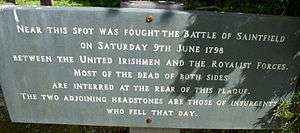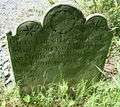Battle of Saintfield
The Battle of Saintfield was a short but bloody clash in County Down, in Northern Ireland. The battle was the first major conflict of the Irish Rebellion of 1798 in Down. The battle took place on Saturday, 9 June 1798.
| Battle of Saintfield | |||||||
|---|---|---|---|---|---|---|---|
| Part of the United Irishmen Rebellion | |||||||
 Plaque commemorating the battle. | |||||||
| |||||||
| Belligerents | |||||||
|
|
| ||||||
| Commanders and leaders | |||||||
|
Richard Frazer McKinstry (KIA) | Granville Staplyton | ||||||
| Strength | |||||||
| 1,000 at least | 350, two six-pounder guns | ||||||
| Casualties and losses | |||||||
| 30–40 killed |
58 killed ~10 captured | ||||||
Background
A rebel force, over a thousand strong, converged on a large house owned by the McKee family. The McKees were a family of loyalists, who were unpopular in the region: one year before, they had provided information to the authorities leading to the arrest of a radical Presbyterian minister by the name of Thomas Ledlie Birch and some members of his congregation. The McKees knew that they were unpopular and were thus armed to the teeth. As the house was surrounded, shots were fired from the fortified house, hitting some of the attackers. Gunfire held the insurgents back for a short while, until one of them, a fiddler by the name of Orr, managed to sneak around the back of the house with a ladder, and thence set the roof alight. The house was destroyed, and all eight members of the family inside killed. News of this quickly reached the British forces in the area, and a 300 strong force under Colonel Granville Staplyton, consisting of Newtownards Yeomanry cavalry and 270 York Fencibles, as well as two light cannon, marched to the region.
The battle
The rebels, however, had anticipated the move and were waiting in ambush. Stapylton saw the road ahead twisting into woods, and ordered a pair of scouts to check for anything suspicious. The men do not seem to have been particularly vigilant, as when they returned they declared that the road ahead was safe.
The redcoats marched into the wooded area, a dense hedge snaking along the road on one side: on the opposite side, the ground steadily rose, with the areas higher up the slope dominated by demesne woods. This provided cover for the Irish. The Irish rebels were mostly armed with pikes and the terrain allowed them to quickly swarm the soldiers on the road below. In the fierce hand-to-hand combat that followed the British forces were overwhelmed. One of the fencibles, a veteran of wars in Europe who managed to survive the attack later stated that he had never before witnessed such fierce fighting: every man had to fight his way in the best manner he could in opposition to the charged pike and other weapons, to which he had not been accustomed.
Over fifty men were piked to death before Staplyton managed to order the soldiers; he then brought his cannon into play against the mass of rebels before him, inflicting enough casualties with canister and grapeshot to blunt their attack. In the meantime, Staplytons force used the situation to march to safety.
Aftermath
The battle of Saintfield was largely regarded as a victory of the United Irish rebels. Long after, in the 1950s, two skeletons and a sword and bayonet of the York fencibles were found in the area.
The rebellion in Down would prove short lived, however- only a few days later the rebel army was slaughtered at the Battle of Ballynahinch.
Many of the dead from both sides of the battle were placed in a mass grave within the grounds of the nearby Presbyterian church. Although there is a plaque signifying the location of these graves, the area seems largely neglected with what appears to be temporary vehicle access over the belligerents final resting place. In May 2010 a memorial park was finished and opened. The area has been cleared and landscaped, with several new plaques and information boards being erected. The graves have been refurbished and the headstones relaid.
- 1798 United Irishmen graves
 Gravestone of James McEwen of Ballymaccreely
Gravestone of James McEwen of Ballymaccreely Gravestone of John Lowry of Killinchy
Gravestone of John Lowry of Killinchy
References
- Stewart, A.T.Q. The Summer Soldiers: The 1798 Rebellion in Antrim and Down (1995)